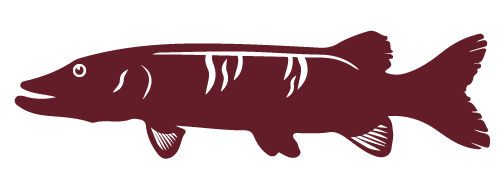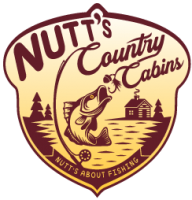Questions? Call 1-844-905-1001
Fishing at Nutt's Country Cabins
Currently opened from May to October, Nutt’s Country Cabins offers a variety of fishing and weather conditions.
May and the beginning of June are considered the spring season with Walleye and Northern fresh out of the spawn - the action is brisk. The Perch know no season and are plentiful throughout the year.
In summer, July and August produces some of our best fishing although it is done in considerably deeper waters. The plus to deep water fishing is that more trophies are caught during the summer period than at any other time.
The fall season, September and October brings the fishing back into shallow waters and some exciting casting action.
Special attention should be used when fishing deep waters. Lake trout can equalize pressure changes rapidly if brought to the surface from depths of 60 feet or deeper. Often you will notice how a fish burps which indicates how a trout gets rid of excess air which is expanding in the bladder as the fish is brought to the surface. Other fish don't have this pressure equalizing ability. When bringing a Northern Pike or Walleye up from a depth of 30 feet or more, it will only survive if they are brought to the surface slowly and released immediately. Fishing methods must be adjusted to suit the species you are seeking in comparison to retrieving a walleye from 10 feet of water to a lake trout in 60 feet of water.
Whatever time you choose you will want to bring your camera, for the lakes surrounding you are loaded with wildlife, as well as the renowned sunsets followed by the Canadian northern lights
Where can you travel in a reasonable amount of time, at a reasonable cost and still experience excellent walleye fishing in a true wilderness setting?
Tips & Tricks:
1. Fishing is like hunting. Get a good depth map of the lake or water system you are fishing which can be purchased at camp or several local bait shops.
2. When fishing for trophy northern in the summer, go to a mature weed bed and look for a 15 foot drop off - that drop off is where the big fish are.
3. Walleyes aren’t hard to catch, as much as they are hard to locate. A good locator is almost a must and will be a worthwhile investment.
4. Northern pikes eyes are on the top of their heads so present your baits above them.
5. When using night crawlers for game fish, always use the whole worm. More to see, more to taste and more to smell.
6. Ask the camp manager what kind of bait fish are in the waters. Try to match your artificial baits to the natural colors the fish are feeding on.
7. Always make sure your bait is on the bottom when fishing for walleyes.
8. Always use barbless hooks and bring a pair of long hook outs to remove deep throated hooks.
9. DID YOU KNOW? A 21 inch female walleye would produce on average 98,000 eggs each year.
To ensure released fish survive, anglers must practice good handling techniques to minimize injury and stress to the fish. In this way, anglers who learn and practice good handling techniques will have taken an important step in the wise use and conservation of our fisheries resource.
1. Land your fish as quickly as possible to prevent exhaustion. If you are fishing very deep through different temperature and pressure layers, particularly for walleye, take more time.
2. It is best to keep the fish in the water to release it. If you bring it into the boat or on shore, do not allow it to thrash around or against hard surfaces. Remember our rule of thumb: Hold your breath the second you bring a fish out of the water. When you need air so does the fish - so release it back to its natural environment.
3. Handle fish gently. Keep your hands wet. Don't put your fingers in the eye socket or the gills and try not to squeeze the fish in the stomach area. A wet glove is the ideal method to protect your fingers and the fish's mucous covering.
4. Remove the hook quickly with long nosed pliers. If the hook is deep in the throat, cut the line and leave the hook. Prevent bleeding. Keep the required equipment ready.
5. Pinch the barbs off all your hooks. It is a safe and efficient way to release all fish species.
6. If the fish is sluggish, hold it parallel to the boat in the water, by the tail and move it back and forth slowly to pass water through the gills. When the fish begins to struggle (it might take a couple of minutes) let it go.
7. If lifting a fish out of the water to take a picture, keep the fish horizontal. If held vertical you are putting unnecessary stress on the neck and backbone.
8. Sign up your released trophy fish with our local MASTER ANGLER PROGRAM.
Zone 4 Fishing Regulations – Zone Wide Seasons and Limits:
**See fishing regulations for Waterbody Exceptions, Species Exceptions and Fish Sanctuaries at https://www.ontario.ca/page/fishing and select Zone 4 under the Fishing Season**

Walleye
Season: January 1st – April 14, and reopens on the 3rd Saturday in May to December 31st
Daily Limits: Sport 4, Conservation 2
Size Limits: Not more than 1 greater than 46 cm or 20.9”

Northern Pike
Season: Open All Year
Daily Limits: Sport 4, Conservation 2
Size Limits: None between 70 – 90 cm or 27.6” – 35.4”, Not more than 1 greater than 90 cm or 35.4”

Small Mouth Bass
Season: Open All Year
Daily Limits: January 1st –June 30th Sport 2, Conservation 1
July 1st – November 30th Sport 4, Conservation 2
December 1st – 31st Sport 2, Conservation 1
Size Limits: January 1st - June 30th must be less than 35 cm or 13.7”
July 1st – November 30th No size limits
December 1st – 31st must be less than 35 cm or 13.7”

Muskellunge
Season: 3rd Saturday in June to December 15th
Daily Limits: Sport 1, Conservation 0
Size Limits: Sport - Must be greater than 102 cm or 40.2”

Lake Trout
Season: January 1st – September 30th
Daily Limits: Sport 2, Conservation 1
Size Limits: Sports – not more than 1 greater than 56 cm or 22”, Conservation - No size limits

Brook Trout
Season: January 1st – Labour Day
Daily Limits: Sport 5, Conservation 2
Size Limits: Not more than 1 greater than 30 cm or 11.8”
Additional Information:
1. All fish must be kept whole while on the water unless prepared for shore lunch.
2. All fish must be frozen flat with a piece of skin left on to identify the species. Only two fillets per package.
3. The possession limit is the number you are allowed to have in your possession on hand, in cold storage, in
transit, etc.
4. Fish caught that day and eaten are counted as part of your daily catch limit.
Tackle Reference Chart:
WALLEYE
Jigs - by far the most popular bait. Use a 1/2 oz. to 3/8 oz. The trick is to be able to feel the bottom of the lake. Choose a variety of colours such as chartreuse, pink, yellow, orange. Tip these jigs with a minnow or a worm and a successful fisherman you will be. You might want to try my favourite Canadian lure that being the Whistler Joe. You’ll love the action the propeller on the whistler creates. Yup - one little plastic box containing jigs, tails, and whistler Joes. One last tip - use a snap swivel to ensure the line does not twist - #9 is the recommended snap.
SMALLMOUTH BASS
Top water baits works well in the spring - Tiny Torpedoes, Buzz Baits, Floating Rapalas (Size #9). Spring to Fall you may want to try plastic body baits such as Beetle Spins, twister tail on a 1/4 oz. jig (black tails to imitate a leech).
LAKE TROUT
Artificial lures only are allowed on Big Vermilion Lake. Try a Sutton Spoon, Flutter Spoons with colours like Chartreuse, Orange and Silvers. Remember you will need egg sinkers to weight your spoon down during the summer months.
NORTHERN PIKE
Action mixed with fun when catching these critters. Use Spoons with weights of 1/2 oz. to 3/4 oz. You most likely have them in your tackle box - Dare Devils, Silver Minnows, and Little Cleo’s -in various colours. Always carry a variety of baits, shiny baits for sunny days (silver, gold and copper) and try the bright colours for the darker days (chartreuse, red and white, and florescent). A real must is to use anywhere from a 9 inch to 14 inch leader.
MUSKIE
In the spring use Bucktails 3" to 4" - Black/orange and yellow. Smaller lures will out produce big Muskie-sized baits. In the summer use Jerk Baits, Bucktails, Jigs and artificials, Buzzing baits, and Crank Baits. Colours - a variety but include black, orange, yellow and red. In the fall use Jerk Baits of various colours.
Recipes:
Northern Chowder
STEP ONE: Sauté 3 garlic cloves, onion, and 2 tsp. of butter. Add 6 potatoes (cubed small), 6 carrots, 3 or 4 stalks celery, salt & pepper, and enough water to cover. Boil till 3/4 done. Add fish and cook till its white.
STEP TWO: Making the White Sauce: Sauté onion and 2 tsp. of butter. Thicken with 1/2 cup of flour and 2 cups of milk. Add lots of salt and pepper. Add this mixture to step one
TIP: Add 1 can tomatoes, cayenne and red pepper for Cajun style.
Pizza Northern
STEP ONE: Lie Northern Pike on a piece of tin foil, and add ingredients: 1 can of tomato sauce or Tomatoes sliced up to cover fish, Parsley Season, Salt, Garlic Power, Onions, Lemon Juice, Butter, and a Sprinkle of Worcestershire.
STEP TWO: You can choose to Bake it in the oven or BBQ it for approximately 20 minutes.
STEP THREE: Added Shredded Mozzarella Cheese, 5 minutes before serving. Enjoy!!
Wind: 6mph ESE
Humidity: 99%
Pressure: 29.77"Hg
UV index: 0
57°F / 36°F
64°F / 45°F
Nutt's Country Cabins, 2076 Highway 664, Sioux Lookout, ON P8T 0A7
Copyright © 2019 NuttsCountryCabins.com | Privacy Policy | Website design by: Little Dragon Media

